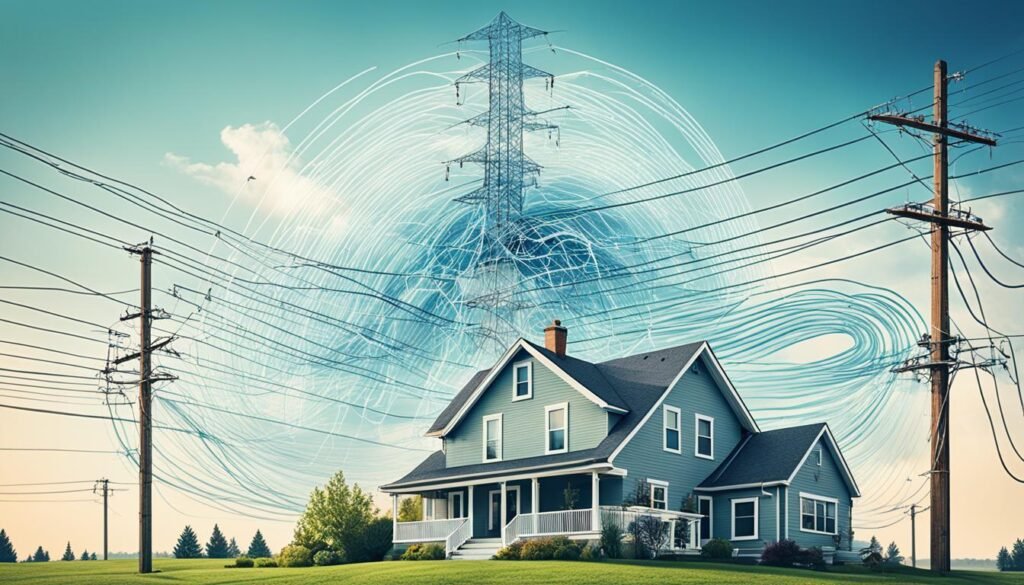Disclosure: This Post Contains Affiliate Links; We earn a commission on purchases.
Electromagnetic fields (EMFs) are a part of our daily lives, generated by both natural and artificial sources. While the impact of EMF exposure on health is still being studied, it’s important to understand the potential risks and explore ways to protect ourselves.
EMF Decoding entails understanding the complexities of electromagnetic field analysis, evaluating EMF protection solutions, and staying informed about the latest advancements in EMF shielding technology and EMF radiation detection. By decoding EMFs, we can make informed decisions to minimize unnecessary exposure and mitigate potential health risks.
Key Takeaways:
- EMFs are invisible areas of energy or radiation produced by charged particles in motion.
- They can come from natural sources and everyday devices like smartphones and Wi-Fi routers.
- Research on the health effects of EMF exposure is ongoing, and views on the risks can vary.
- Minimizing exposure to EMFs through simple precautionary measures is recommended.
- Various EMF protection solutions, such as shielding technology and harmonizing devices, are available, but their effectiveness is still debated.
Understanding Electromagnetic Fields
Electromagnetic fields (EMFs) are areas of energy or radiation that form when charged particles, such as electrons or protons, move. They can be produced by natural sources like the Earth’s magnetic field or artificial sources like electronic devices.
EMFs can be categorized into two types: low-frequency EMFs and high-frequency EMFs. Low-frequency EMFs are generated by household appliances and power lines, while high-frequency EMFs are emitted by devices like smartphones and Wi-Fi routers.
The concern about high-frequency EMFs arises from the long-term exposure and potential heating effects on bodily tissues. It is important to differentiate between different types of EMFs and consider their potential impacts on health.
In summary:
- EMFs are areas of energy or radiation formed by charged particles
- Natural and artificial sources contribute to the formation of EMFs
- Low-frequency EMFs come from household appliances and power lines
- High-frequency EMFs are emitted by devices like smartphones and Wi-Fi routers
- Understanding the different types of EMFs is crucial in evaluating their potential health effects
For a visual representation of how EMFs are generated, refer to the diagram below:
Quote:
Understanding the nature of electromagnetic fields is key to comprehending their potential impact on our health and well-being. By differentiating between low-frequency and high-frequency EMFs and staying informed about their sources, we can make informed choices to minimize unnecessary exposure and safeguard our vitality.
The Health Impact of EMF Exposure
The health impact of EMF exposure, especially high-frequency EMFs, is a subject of ongoing research. Some studies suggest that high-frequency EMFs may cause cellular stress, which can potentially harm cells in the long run. There are also concerns about EMFs affecting sleep quality and disrupting cognitive functions like memory, attention, and mood. Additionally, fertility concerns have been raised, with some studies indicating a potential impact on sperm quality.
However, it is important to note that views on the health risks associated with EMF exposure can vary, and organizations like the World Health Organization suggest that current EMF exposure levels are not worrisome. Keeping abreast of the latest research is recommended to stay informed about any developments or new findings.
While further research is needed to fully understand the long-term effects of EMF exposure, it is essential to be mindful of potential health risks and take appropriate precautionary measures to minimize unnecessary exposure. This includes adopting practices that promote overall well-being, such as ensuring a balanced lifestyle, getting quality sleep, practicing stress management techniques, and following a healthy diet.
“Studies suggest that high-frequency EMFs may cause cellular stress, which can potentially harm cells in the long run.”
Types of EMF and Their Sources
Electromagnetic fields (EMFs) can be categorized into two types: low-frequency and high-frequency. Each type has different sources and potential exposure risks.
Low-Frequency EMFs
Low-frequency EMFs are generated by various sources commonly found in our daily lives. These sources include household appliances like refrigerators, televisions, and washing machines, as well as power lines and electrical wiring. Low-frequency EMFs have a frequency range of 0-100 kilohertz.
High-Frequency EMFs
On the other hand, high-frequency EMFs come from devices such as smartphones, Wi-Fi routers, and microwave ovens. These devices emit electromagnetic radiation in the high-frequency range, which typically spans from 100 kilohertz to 300 gigahertz. It is important to be aware of these sources as they can contribute to our overall exposure to EMFs.
| Type of EMF | Sources |
|---|---|
| Low-Frequency EMFs | Household appliances, power lines, electrical wiring |
| High-Frequency EMFs | Smartphones, Wi-Fi routers, microwave ovens |
Understanding the sources of EMFs allows us to make informed decisions about reducing our exposure to these fields. By minimizing contact with devices that emit high-frequency EMFs and being mindful of our proximity to low-frequency EMF sources, we can help mitigate potential risks associated with EMF exposure.

Minimizing EMF Exposure
While the current evidence suggests that EMFs at typical exposure levels are safe, it is still good practice to minimize exposure to EMFs. Taking precautionary measures can help reduce unnecessary EMF exposure and promote overall well-being.
Precautionary Measures to Minimize EMF Exposure
Here are some simple steps you can take to minimize your exposure to EMFs:
- Use earphones: Instead of placing your smartphone directly against your ear, use earphones or a hands-free device. This can reduce EMF exposure to your head and brain.
- Keep Wi-Fi routers away from sleeping areas: Position your Wi-Fi router in a central location away from where you sleep. This helps minimize EMF exposure during the night when your body needs rest and recovery.
- Avoid sleeping with laptops nearby: Laptops emit EMFs, so it’s best to keep them away from your sleeping area. Charge your laptop in a different room or switch it off before going to bed.
By adopting these simple precautionary measures, you can limit your exposure to EMFs and potentially reduce any associated risks.
“Minimizing exposure to EMFs is an important aspect of maintaining a healthy lifestyle. Taking small steps, such as using earphones and keeping Wi-Fi routers away from sleeping areas, can contribute to reducing unnecessary EMF exposure.”

| Precautionary Measures | Benefits |
|---|---|
| Using earphones | Reduces direct exposure of EMFs to the head and brain. |
| Keeping Wi-Fi routers away from sleeping areas | Minimizes EMF exposure during resting hours, promoting better sleep quality. |
| Avoiding sleeping with laptops nearby | Reduces EMF exposure during sleep and supports a healthier sleeping environment. |
EMF Protection Solutions
When it comes to protecting ourselves from the potential risks of EMF exposure, there are several solutions available in the market. These solutions aim to minimize or mitigate the effects of electromagnetic fields, providing peace of mind and a sense of security. Two common types of EMF protection solutions are EMF shielding technology and EMF harmonizing devices.
EMF Shielding Technology
EMF shielding technology is designed to block or reduce the penetration of electromagnetic fields into our living spaces. It usually involves the use of materials that have high conductivity and can create a barrier against EMFs. Some common examples of EMF shielding technology include shielding paint, shielding fabrics, and shielding films. These products can be applied to walls, windows, or electronic devices to create a protective shield against EMFs.
EMF Harmonizing Devices
EMF harmonizing devices, on the other hand, work by emitting frequencies that are claimed to counteract the harmful effects of EMFs. These devices use various techniques such as frequency modulation, resonance, or scalar wave technology to harmonize the electromagnetic fields around us. The idea is that by introducing specific frequencies, the detrimental effects of EMFs can be neutralized or minimized. EMF harmonizing devices come in different forms, including pendants, bracelets, stickers, and even smartphone cases.
While EMF protection solutions offer a potential way to minimize exposure to electromagnetic fields, it is important to note that their effectiveness is still a matter of debate. The scientific community has differing views on the efficacy of these solutions, and individual preferences may vary. It is always recommended to consult experts in the field and conduct thorough research before investing in any EMF protection solution.
Remember, the goal of EMF protection is to create a safe and healthy environment. By staying informed about the latest research, understanding the potential risks of EMF exposure, and exploring different protection options, you can make informed decisions to safeguard yourself and your loved ones.
EMF Mitigation Techniques
Reducing EMF exposure is not only about using protection solutions but also implementing effective mitigation techniques. By employing these techniques, you can create a safer environment and minimize unnecessary exposure to electromagnetic fields.
Create EMF-Free Zones
One effective strategy is to create EMF-free zones in your living and sleeping areas. This involves minimizing the presence of electronic devices, such as smartphones and laptops, in these designated areas. By keeping these spaces free from EMF-emitting devices, you can significantly reduce your overall exposure.
Use Wired Connections
If possible, opt for wired connections instead of wireless options for internet access and communication. Using wired connections, such as ethernet cables for internet connectivity, can help reduce the amount of electromagnetic radiation you are exposed to. This is especially beneficial for areas where you spend a considerable amount of time, such as your home or office.
Position Electronic Devices Wisely
Another important consideration is the positioning of electronic devices. Keep devices like smartphones, laptops, and tablets at a safe distance when they are in use. This minimizes the electromagnetic radiation emitted directly towards your body. Additionally, avoid placing electronic devices in close proximity to areas where you spend a significant amount of time, such as your bedside table or work desk.
Remember: Small changes in the way you position and use electronic devices can make a big difference in reducing your overall EMF exposure.
By implementing these mitigation techniques, you can take proactive steps towards reducing your exposure to electromagnetic fields. Creating EMF-free zones, using wired connections, and positioning electronic devices wisely are simple yet effective measures that promote a healthier living environment.
Comparison of EMF Mitigation Techniques
| Mitigation Techniques | Effectiveness | Cost | Implementation Complexity |
|---|---|---|---|
| Create EMF-Free Zones | High | Low | Low |
| Use Wired Connections | Moderate | Low | Low |
| Position Electronic Devices Wisely | Moderate | None | Low |
Note: Effectiveness, cost, and implementation complexity can vary based on individual circumstances.
Conclusion
Decoding EMFs and understanding their potential risks is an ongoing process as scientific research continues to provide insights into their impact on health. While current evidence suggests that typical EMF exposure levels are not cause for immediate concern, it is important to stay informed about the latest research and take precautionary measures to minimize unnecessary exposure. EMF protection solutions and mitigation techniques can be considered based on individual preferences and circumstances. By adopting proactive measures, individuals can make informed decisions to protect themselves against potential EMF risks.
Source Links
- https://oneearthhealth.com/blogs/health-news/decoding-the-emf-puzzle-are-electromagnetic-fields-a-concern
- https://www.healthandenvironment.org/docs/xaruploads/EMFSourcesAndChoices.pdf
- https://defendershield.com/decoding-superhuman-defend-yourself-against-emf-exposure

Subscribe to Our Newsletter










